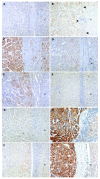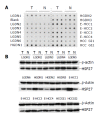Expression of heat shock proteins (HSP27, HSP60, HSP70, HSP90, GRP78, GRP94) in hepatitis B virus-related hepatocellular carcinomas and dysplastic nodules
- PMID: 15810071
- PMCID: PMC4305774
- DOI: 10.3748/wjg.v11.i14.2072
Expression of heat shock proteins (HSP27, HSP60, HSP70, HSP90, GRP78, GRP94) in hepatitis B virus-related hepatocellular carcinomas and dysplastic nodules
Abstract
Aim: Expression of heat shock proteins (HSPs) is frequently up-regulated in hepatocellular carcinoma (HCC), which evolves from dysplastic nodule (DN) and early HCC to advanced HCC. However, little is known about the differential expression of HSPs in multistep hepatocarcinogenesis. It was the purpose of this study to monitor the expression of HSPs in multistep hepatocarcinogenesis and to evaluate their prognostic significance in hepatitis B virus (HBV)-related HCC.
Methods: Thirty-eight HCC and 19 DN samples were obtained from 52 hepatitis B surface antigen-positive Korean patients. Immunohistochemical and dot immunoblot analyses of HSP27, HSP60, HSP70, HSP90, glucose regulated protein (GRP)78, and GRP94 were performed and their expression at different stages of HCC development was statistically analyzed.
Results: Expression of HSP27, HSP70, HSP90, GRP78, and GRP94 increased along with the stepwise progression of hepatocarcinogenesis. Strong correlation was found only in GRP78 (Spearman's r = 0.802). There was a positive correlation between the expressions of GRP78, GRP94, HSP90, or HSP70 and prognostic factors of HCC. Specifically, the expression of GRP78, GRP94, or HSP90 was associated significantly with vascular invasion and intrahepatic metastasis.
Conclusion: The expressions of HSPs are commonly up-regulated in HBV-related HCCs and GRP78 might play an important role in the stepwise progression of HBV-related hepatocarcinogenesis. GRP78, GRP94, and HSP90 may be important prognostic markers of HBV-related HCC, strongly suggesting vascular invasion and intrahepatic metastasis.
Figures


Similar articles
-
Expressions of HSP70 and HSP27 in hepatocellular carcinoma.J Korean Med Sci. 2005 Oct;20(5):829-34. doi: 10.3346/jkms.2005.20.5.829. J Korean Med Sci. 2005. PMID: 16224158 Free PMC article.
-
Proteomic profiling of hepatocellular carcinoma in Chinese cohort reveals heat-shock proteins (Hsp27, Hsp70, GRP78) up-regulation and their associated prognostic values.Proteomics. 2006 Feb;6(3):1049-57. doi: 10.1002/pmic.200500306. Proteomics. 2006. PMID: 16400691
-
Expression of heat shock proteins in medulloblastoma.J Neurosurg Pediatr. 2013 Nov;12(5):452-7. doi: 10.3171/2013.7.PEDS1376. Epub 2013 Aug 30. J Neurosurg Pediatr. 2013. PMID: 23992239
-
Immunohistochemical localization and expression of heat shock proteins (HSP27, HSP60, HSP70, and HSP90) during the oestrous cycle, pregnancy, and lactation in rat ovaries.Acta Histochem. 2024 Apr;126(3):152157. doi: 10.1016/j.acthis.2024.152157. Epub 2024 Apr 5. Acta Histochem. 2024. PMID: 38581753 Review.
-
Modulatory effects of curcumin on heat shock proteins in cancer: A promising therapeutic approach.Biofactors. 2019 Sep;45(5):631-640. doi: 10.1002/biof.1522. Epub 2019 May 28. Biofactors. 2019. PMID: 31136038 Review.
Cited by
-
Increased expression of Gp96 by HBx-induced NF-κB activation feedback enhances hepatitis B virus production.PLoS One. 2013 Jun 11;8(6):e65588. doi: 10.1371/journal.pone.0065588. Print 2013. PLoS One. 2013. PMID: 23776506 Free PMC article.
-
Evidence of prognostic relevant expression profiles of heat-shock proteins and glucose-regulated proteins in oesophageal adenocarcinomas.PLoS One. 2012;7(7):e41420. doi: 10.1371/journal.pone.0041420. Epub 2012 Jul 24. PLoS One. 2012. PMID: 22911792 Free PMC article.
-
Network-based analysis of calcium-binding protein genes identifies Grp94 as a target in human oral carcinogenesis.Br J Cancer. 2007 Sep 17;97(6):792-801. doi: 10.1038/sj.bjc.6603948. Epub 2007 Aug 28. Br J Cancer. 2007. PMID: 17726464 Free PMC article.
-
Using proteomic approach to identify tumor-associated antigens as markers in hepatocellular carcinoma.J Proteome Res. 2008 Sep;7(9):4004-12. doi: 10.1021/pr800273h. Epub 2008 Aug 2. J Proteome Res. 2008. PMID: 18672925 Free PMC article.
-
Glucose-regulated protein 94 (Grp94/gp96) in viral pathogenesis: Insights into its role and therapeutic potentials.Eur J Med Chem. 2025 Aug 5;292:117713. doi: 10.1016/j.ejmech.2025.117713. Epub 2025 Apr 30. Eur J Med Chem. 2025. PMID: 40319577 Free PMC article. Review.
References
-
- Anthony PP. Hepatocellular carcinoma: an overview. Histopathology. 2001;39:109–118. - PubMed
-
- Terminology of nodular hepatocellular lesions. Hepatology. 1995;22:983–993. - PubMed
-
- Hirohashi S, Ishak KG, Kojiro M, Wanless IR, Theise ND, Tsukama H, Blum HE, Deugnier Y, Laurent Puig P, Fischer HP, et al. Tumors of the liver and intrahepatic bile ducts. Hepatocellular carcinoma. In: Hamilton SR, Aaltonen LA, eds , editors. WHO classification. Tumours of the digestive system. 2nd ed. Lyon: IARC; 2000. p. 167.
-
- Kojiro M. Pathological evolution of early hepatocellular carcinoma. Oncology. 2002;62 Suppl 1:43–47. - PubMed
-
- Sakamoto M, Hirohashi S, Shimosato Y. Early stages of multistep hepatocarcinogenesis: adenomatous hyperplasia and early hepatocellular carcinoma. Hum Pathol. 1991;22:172–178. - PubMed
Publication types
MeSH terms
Substances
LinkOut - more resources
Full Text Sources
Other Literature Sources
Medical
Research Materials
Miscellaneous

